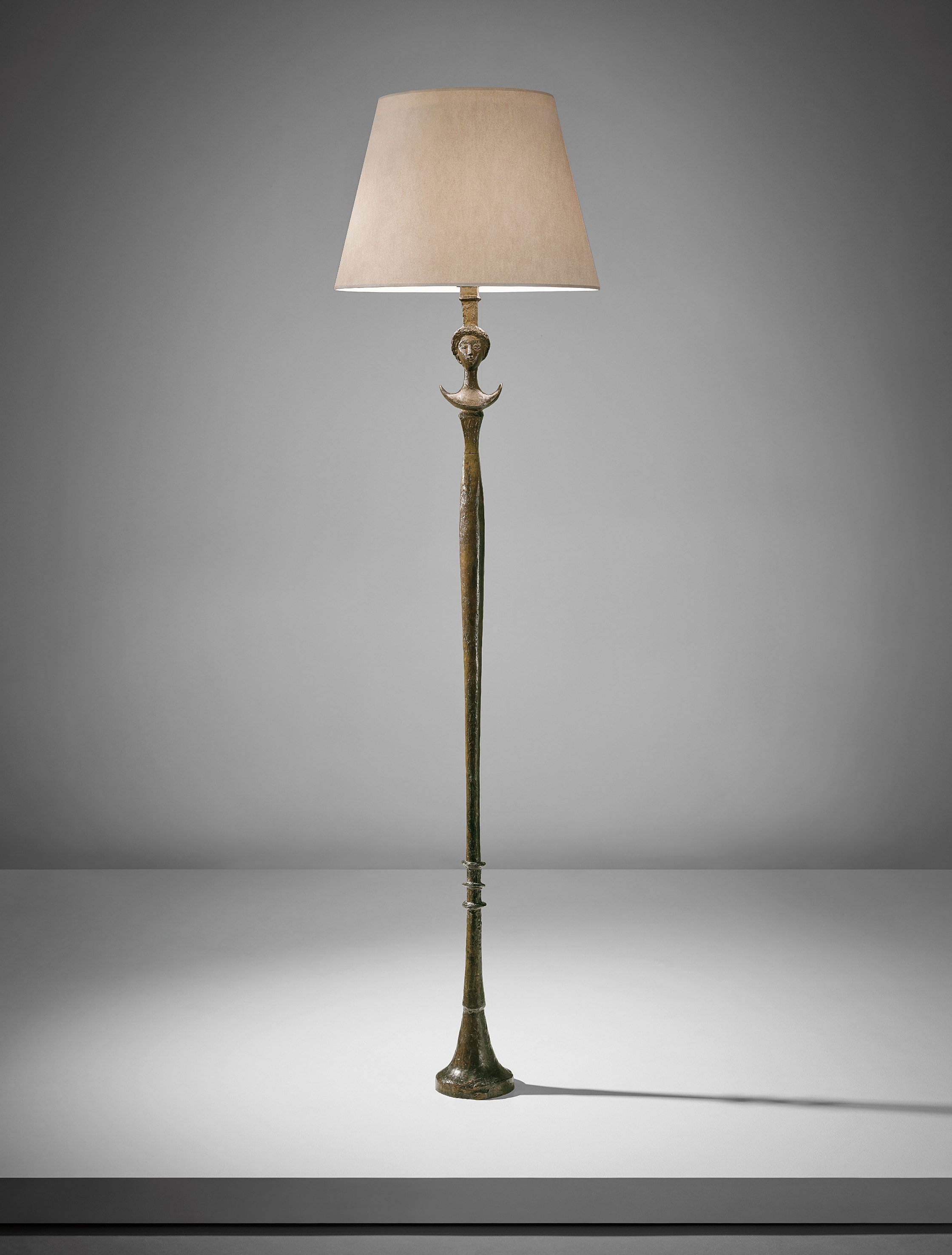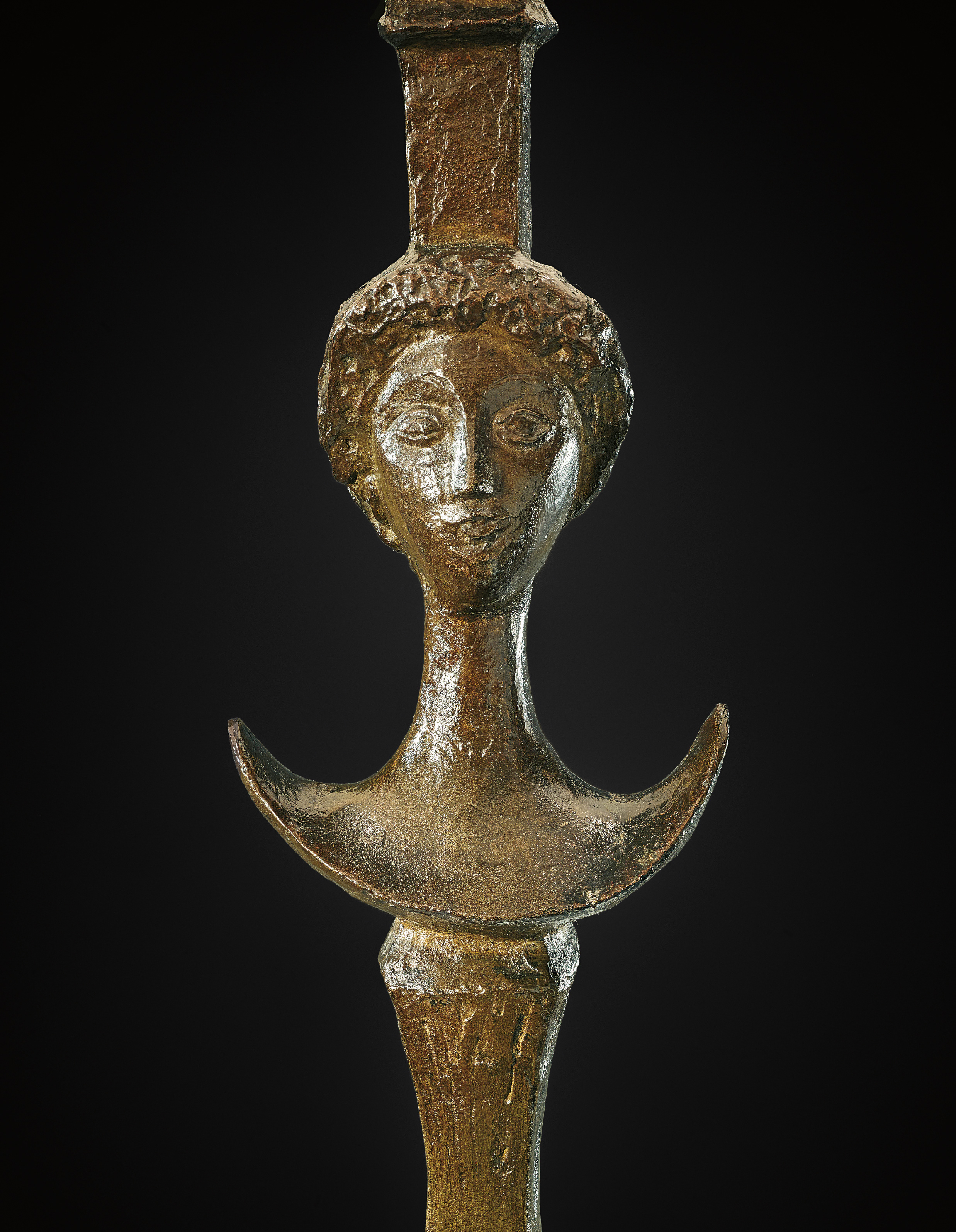



Property of a Gentleman
219
Alberto Giacometti
Early “Figure” floor lamp (thin version)
1933-1939
Patinated bronze, paper shade.
Height of cast: 61 3/8 in. (155.9 cm)
Base impressed AG 01. Together with a certificate of authenticity from the Comité Giacometti.
Full-Cataloguing
The present lot is registered by the Fondation Alberto and Annette Giacometti in the online Alberto Giacometti Database (AGD) under the number AGD 2800.
Giacometti, "Figure" floor lamp
Alberto Giacometti’s totemic vision of the figure in his "Figure" floor lamp appears fragile and seemingly timeless. The sculpted female figure evokes an ancient caryatid, whose simplified form is at once supportive and decorative, blurring the boundaries between sculpture and object. The suggestive possibilities of the patinated bronze floor lamp reflect Giacometti’s exploration of metaphorical associations in his objects during the 1930s, resulting in works poised between the archaic and the modern.
The "Figure" floor lamp comprises part of the collection of decorative objects that Giacometti created for the influential interior designer Jean-Michel Frank between 1932 and 1940. One of the first to discover Giacometti’s talent, Frank commissioned over seventy designs from the sculptor, which he prominently featured throughout his interiors. Translating the spirit of Frank’s anonymity of forms and space, Giacometti worked from ancient models, while also finding inspiration in African sculpture. Giacometti traced the genesis of these forms, emptying them of their meaning, in order to retain only the essential. Evoking forms from ancient Greek, Roman, and Egyptian excavations, Giacometti’s decorative works reflect his admiration of these civilizations and his study of their utilitarian objects. However, devoid of any direct historical or cultural reference, these works retain a sense of mysterious anonymity, allowing the viewer to unconsciously construct the work’s form and meaning – a reciprocal influence that can be traced in Giacometti and Frank’s work.
Frank’s celebrated minimalist interiors, which featured unexpected materials and combined simplicity of line and form, earned him wide acclaim among Paris’s artistic and intellectual circles from which Frank established important patronage and friendships. Such relationships were instrumental to Frank’s practice and through these collaborations the designer created some of the most celebrated modern interiors of the twentieth century. Frank’s innovative collaborative approach to design found a counterpart in the Italian-born fashion designer Elsa Schiaparelli. Revered for her highly imaginative creations and unmatched ability to shock and surprise, Schiaparelli’s work combines fantasy and metaphor, reflecting her artistic exchange with leading artists of the Surrealist movement. Working in Paris between the two World Wars, Schiaparelli’s designs reflect her exploration of avant-garde ideas of the period, a narrative that is woven into her work. Schiaparelli’s œuvre parallels that of Frank’s in terms of her skillful use of unexpected materials combined with a technical proficiency for line and proportion, together expressed through an extraordinary vision.
Schiaparelli turned to Frank to create a series of striking interiors that would become the setting for her professional and personal life in Paris. Beginning in 1927 Frank created Schiaparelli’s first boutique-combined residence on the rue de la Paix. Then in 1931, as Schiaparelli’s reputation continued to quickly grow, Frank designed the couturier a separate residence on boulevard Saint Germain, followed by a residence on the rue Barbet-de-Jouy in 1934. The following year, on the occasion of her new couture showroom at the legendary address of 21 place Vendôme, Schiaparelli again entrusted Frank for its interior design. Giacometti created several pieces for the showroom, comprising vases, chandeliers, and candlesticks in plaster, and lamps cast in bronze. Dating from this fruitful period of collaboration, Giacometti created the present lot for Schiaparelli, likely for her private mansion on rue de Berri designed by Frank in 1937.
Giacometti’s "Figure" floor lamp shares a spirit of Surrealism that had provided the creative environment in which Schiaparelli flourished. Giacometti had joined the Surrealists in 1931 and although he parted ways with the group by 1935 elements of the movement remained in his work. By the mid-1930s Giacometti had turned his attention back to the depiction of the human figure, and specifically to the human head. Uniting the psychological and the physical, the exploration of the head would remain central to Giacometti’s work throughout his life. During this period Giacometti also created pieces of bronze jewelry for Schiaparelli featuring mythological, female and animal motifs, which bring to mind the artist’s rough-cast sculpture.
The present lot is an early example of Giacometti’s "Figure" floor lamp, conceived by the artist between 1933 and 1934. Produced until 1939, this early version of the lamp features a narrow base, which Giacometti widened in later examples. A human quality is evoked by the lamp’s tactility, reduced to its essential form. Upon its creation, the elegant totemic figure combined influences from past and present, and today remains emblematic of a unique collaboration.
Giacometti, "Figure" floor lamp
Alberto Giacometti’s totemic vision of the figure in his "Figure" floor lamp appears fragile and seemingly timeless. The sculpted female figure evokes an ancient caryatid, whose simplified form is at once supportive and decorative, blurring the boundaries between sculpture and object. The suggestive possibilities of the patinated bronze floor lamp reflect Giacometti’s exploration of metaphorical associations in his objects during the 1930s, resulting in works poised between the archaic and the modern.
The "Figure" floor lamp comprises part of the collection of decorative objects that Giacometti created for the influential interior designer Jean-Michel Frank between 1932 and 1940. One of the first to discover Giacometti’s talent, Frank commissioned over seventy designs from the sculptor, which he prominently featured throughout his interiors. Translating the spirit of Frank’s anonymity of forms and space, Giacometti worked from ancient models, while also finding inspiration in African sculpture. Giacometti traced the genesis of these forms, emptying them of their meaning, in order to retain only the essential. Evoking forms from ancient Greek, Roman, and Egyptian excavations, Giacometti’s decorative works reflect his admiration of these civilizations and his study of their utilitarian objects. However, devoid of any direct historical or cultural reference, these works retain a sense of mysterious anonymity, allowing the viewer to unconsciously construct the work’s form and meaning – a reciprocal influence that can be traced in Giacometti and Frank’s work.
Frank’s celebrated minimalist interiors, which featured unexpected materials and combined simplicity of line and form, earned him wide acclaim among Paris’s artistic and intellectual circles from which Frank established important patronage and friendships. Such relationships were instrumental to Frank’s practice and through these collaborations the designer created some of the most celebrated modern interiors of the twentieth century. Frank’s innovative collaborative approach to design found a counterpart in the Italian-born fashion designer Elsa Schiaparelli. Revered for her highly imaginative creations and unmatched ability to shock and surprise, Schiaparelli’s work combines fantasy and metaphor, reflecting her artistic exchange with leading artists of the Surrealist movement. Working in Paris between the two World Wars, Schiaparelli’s designs reflect her exploration of avant-garde ideas of the period, a narrative that is woven into her work. Schiaparelli’s œuvre parallels that of Frank’s in terms of her skillful use of unexpected materials combined with a technical proficiency for line and proportion, together expressed through an extraordinary vision.
Schiaparelli turned to Frank to create a series of striking interiors that would become the setting for her professional and personal life in Paris. Beginning in 1927 Frank created Schiaparelli’s first boutique-combined residence on the rue de la Paix. Then in 1931, as Schiaparelli’s reputation continued to quickly grow, Frank designed the couturier a separate residence on boulevard Saint Germain, followed by a residence on the rue Barbet-de-Jouy in 1934. The following year, on the occasion of her new couture showroom at the legendary address of 21 place Vendôme, Schiaparelli again entrusted Frank for its interior design. Giacometti created several pieces for the showroom, comprising vases, chandeliers, and candlesticks in plaster, and lamps cast in bronze. Dating from this fruitful period of collaboration, Giacometti created the present lot for Schiaparelli, likely for her private mansion on rue de Berri designed by Frank in 1937.
Giacometti’s "Figure" floor lamp shares a spirit of Surrealism that had provided the creative environment in which Schiaparelli flourished. Giacometti had joined the Surrealists in 1931 and although he parted ways with the group by 1935 elements of the movement remained in his work. By the mid-1930s Giacometti had turned his attention back to the depiction of the human figure, and specifically to the human head. Uniting the psychological and the physical, the exploration of the head would remain central to Giacometti’s work throughout his life. During this period Giacometti also created pieces of bronze jewelry for Schiaparelli featuring mythological, female and animal motifs, which bring to mind the artist’s rough-cast sculpture.
The present lot is an early example of Giacometti’s "Figure" floor lamp, conceived by the artist between 1933 and 1934. Produced until 1939, this early version of the lamp features a narrow base, which Giacometti widened in later examples. A human quality is evoked by the lamp’s tactility, reduced to its essential form. Upon its creation, the elegant totemic figure combined influences from past and present, and today remains emblematic of a unique collaboration.